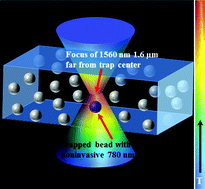Precise control and measurement of solid–liquid interfacial temperature and viscosity using dual-beam femtosecond optical tweezers in the condensed phase†
Abstract
We present a novel method of microrheology based on femtosecond optical tweezers, which in turn enables us to directly measure and control in situ temperature at microscale volumes at the solid–liquid interface. A noninvasive pulsed 780 nm trapped bead spontaneously responds to changes in its environment induced by a co-propagating 1560 nm pulsed laser due to mutual energy transfer between the solvent molecules and the trapped bead. Strong absorption of the hydroxyl group by the 1560 nm laser creates local heating in individual and binary mixtures of water and alcohols. “Hot Brownian motion” of the trapped polystyrene bead is reflected in the corner frequency deduced from the power spectrum. Changes in corner frequency values enable us to calculate the viscosity as well as temperature at the solid–liquid interface. We show that these experimental results can also be theoretically ratified.



 Please wait while we load your content...
Please wait while we load your content...